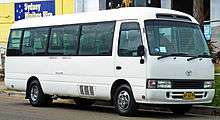Toyota Coaster
| Toyota Coaster | |
|---|---|
.jpg) Toyota Coaster used as a small school bus | |
| Overview | |
| Manufacturer | Toyota Motor Corporation |
| Also called |
Hino Liesse II Joylong HKL6700 |
| Body and chassis | |
| Class | Minibus |
| Body style | Single-decker minibus (short & long body) |
| Floor type | Step entrance |
| Chassis | SWB / LWB / SLWB |
| Related | Daewoo Lestar |
| Powertrain | |
| Engine |
Toyota R-series, B-series, 3F, 2H, 12H, 1HZ, 1HD, 1BZ, 3RZ, 2TR Hino N04C |
| Capacity | 26 /30 |
| Power output | 110 kW |
| Transmission | Manual / Automatic |
| Dimensions | |
| Length | 6,200–7,700 mm (244.1–303.1 in) [1] |
| Width | 2,000 mm (78.7 in) |
| Height | 2,600 mm (102.4 in) |
| Curb weight | 4,990 kg (11,001.1 lb) |
The Toyota Coaster is a single-decker minibus produced by Toyota Motor Corporation. It was introduced in 1969, with the second generation introduced in 1982, followed by the third generation in 1993. The third generation Coaster received a facelift in 2001, and again in 2007. In Japan, the Coaster is sold exclusively at Toyota Store dealerships. Since 1996, the Toyota Coaster is also sold under the name Hino Liesse II.
The Coaster is produced in Japan at Kariya, Aichi (Yoshiwara plant).[2]
In South Korea, the Daewoo Lestar was produced by Daewoo Bus with left hand drive, based on the Toyota Coaster chassis.
A number of unlicensed clones of third generation Coasters have been made in China, including Joylong Motors' HKL6700,[3] Golden Dragon's XML6701[4] and Sunlong Bus' SLK6770.[5] These were sold in China in left hand drive form and in Hong Kong in right hand drive form.
History
The Toyota Coaster was introduced in 1969 as a 17-passenger minibus using the same running gear as the Toyota Dyna of the time. Early models used the 2.0-liter Toyota R engine with 4-speed manual transmission. With 98 PS (72 kW), an RU19 Coaster could reach a top speed of 110 km/h (68 mph).[6] Subsequent models used a variety of four and six-cylinder diesel and petrol engines, and an option of automatic transmission was later introduced. A smaller alternative was later introduced at Toyopet Store locations, based on the Toyota ToyoAce called the Toyota HiAce which had the ability to carry up to 10 passengers but complied with Japanese Government regulations concerning exterior dimensions and engine displacement that the Coaster didn't.
In August 1997, Toyota "Coaster Hybrid EV" minibus was launched, ahead of Prius. The Coaster Hybrid, according to Toyota, became its first production hybrid vehicle.[7] Production of the Coaster Hybrid continued until 2007.
The LPG Coaster, fueled by liquefied petroleum gas, was developed specifically for the Hong Kong market and its air pollution problems.[8] This kind of minibuses are very common in Hong Kong
The Coaster is common not only in Japan, Hong Kong, and Australia, but also in the developing world for minibus operators in Africa, the Middle East, and the Caribbean. It is widely used in Santa Cruz de la Sierra, Bolivia, Panama, and Peru as public transportation. These buses are imported mainly from Asia and had to have the steering wheel moved to the left and the passenger door to the other side.
The chassis of the Toyota Coaster was also used on the Salvador Caetano Optimo and sold in Western Europe.
Variants
- BB10 - 2B engine - First Generation diesel, 22-25 passengers [9]
- RB20 - 22R 2.4 litre gasoline engine, 26 passengers
- BB21/BB22/BB23 3B/13B/14B 4cyl Engine 26 passengers (1981-1993)
- HB30 2H Engine 30 passengers,
- HB31 12H-T Turbo Engine for EX models, sliding door (1981-1990)
- HDB30 1HD-T Turbo Engine for EX models (1989-1993)
- HZB30 1HZ Engine 30 passengers (1990-1993)
- BB40 3B Engine 26 passenger (1993-2003)
- HZB40 1HZ 26 passengers
- HZB50 1HZ 30 passengers (1993-2012)
- HZB51 1HZ Turbo Intercooler 30 passengers (1993-2012)
- HDB50 1HD Turbo Engine, non airbag suspension (1993-2003)
- HDB51 1HD Turbo Engine, airbag suspension (1993-2003)
- BB50 15B-FTE 4-cyl Turbo Intercooled engine (2003-2006) 6sp. manual or auto.
- XZB50/XZB51/XZB56 4-cyl Turbo Intercooled engine (2006 onwards)
- BB58 15B (93-99)/15B-FT (99-2003) 4x4 factory built, it uses the Toyota Mega Cruiser's transmission and front portal axle differentials.
Gallery
|
Conversions
The Toyota Coaster is used for motor home conversions. Retired Coasters are converted for home use by removal of most of the passenger seats, and the addition of beds, kitchens, TV, sink, water tanks, annexes and other fixtures.[10]
See also
References
- ↑ "Toyota Coaster Specs". Toyota Australia. Retrieved 2012-04-22.
- ↑ "Affiliates (Toyota wholly-owned subsidiaries)-Toyota Auto Body Co., Ltd.". Toyota Motor Corporation. 2012. Retrieved 2014-02-14.
- ↑ De Feijter, Tycho (2011-12-22). "Joylong Automobile copies yet Another Toyota". CarNewsChina.com. Beijing. Retrieved 2016-10-04.
- ↑ "Golden Dragon XML6700". Bus Planet. Retrieved 2016-10-04.
- ↑ "SunLong Midbus SLK6770 JUMBO". China Buses. 2011-11-29. Retrieved 2016-10-04.
- ↑ 愛される車づくり。トヨタはあすにいどみます。 [Lovable car manufacture. Toyota dares to defy tomorrow] (catalog) (in Japanese), Toyota Japan, 1972, p. 8
- ↑ "Sales in Japan of TMC Hybrids Top 1 Million Units" (Press release). Toyota Japan. 2010-08-05. Retrieved 2011-10-14.
- ↑ "LPG Coaster - The Green Way to Travel". Toyota Hong Kong. Retrieved 2011-03-10.
- ↑ "Toyota Coaster Variants". Custom Coaster. Retrieved 2012-07-09.
- ↑ "Toyota Coaster Motorhome Conversions Fitout". Australia: First Choice Motorhomes. Retrieved 2016-10-04.
External links
| Wikimedia Commons has media related to Toyota Coaster. |




